
Transforming Resource Conservation with IoT and Machine Learning
As global warming intensifies, water scarcity has become a critical challenge for industries, agriculture, and metropolitan areas. Traditional methods of monitoring and distributing water often rely on human-driven processes, which are error-prone and slow to real-time demands. However, the combination of IoT devices and AI-powered analytics is changing how we manage this vital resource, creating smarter systems that predict needs and prevent waste.
How IoT Work in Tandem with AI
Modern resource networks leverage networks of sensors that track parameters like pH levels, temperature, pressure, and pipe integrity. These units transmit data to cloud-based platforms, where algorithms process patterns to predict usage trends or identify anomalies. For example, a connected farming setup could adjust watering schedules based on soil moisture data, cutting water waste by up to 30% compared to traditional methods. Similarly, municipalities use smart systems to detect leaks in pipelines faster, avoiding the loss of millions of gallons annually.
Essential Elements of a IoT-Driven Solution
Building an efficient system requires interconnected components: hardware, connectivity, and insight generation. Devices placed at critical points—such as reservoirs, distribution hubs, or crop fields—gather real-time data. This information is then routed via cellular or satellite networks to cloud servers, where models analyze datasets to generate actionable insights. For instance, proactive repairs can be activated when machinery shows signs of wear and tear, slowing the likelihood of system breakdowns.
Real-World Applications
In Southeast Asia, the Public Utilities Board uses AI-powered sensors to track water quality across reservoirs, guaranteeing safe drinking supplies while reducing energy consumption. A U.S. state employs similar systems to allocate water during dry spells, prioritizing critical uses like hospitals over less urgent demands. Farming firms in Israel combine moisture detectors with predictive analytics to enhance crop yields while slashing water usage by up to 50%—demonstrating the versatility of these technologies.
Obstacles and Next Steps
Despite their potential, IoT and AI-driven systems face hurdles like high upfront costs, data security risks, and compatibility challenges. Combining legacy systems with modern tech often requires significant investment, while hacking risks demand robust encryption and permission protocols. Looking ahead, advancements in edge computing could reduce latency on cloud platforms, enabling faster decision-making at the site of data collection. Policymakers and private firms must also work together to streamline protocols, ensuring growth across varied use cases.
Final Thoughts
Water management is no longer just about physical infrastructure—it’s a analytics-focused endeavor. By harnessing IoT and AI, organizations can achieve efficiency targets, preserve resources, and create durable systems for future generations. As technology evolves, the collaboration between devices and smart software will only grow stronger, ushering in a new era of precision in global water stewardship.